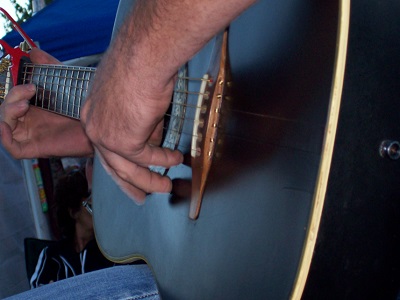Acoustic Fingerpicking For Beginners
 The acoustic guitar is a great way to get your foot in the door when learning how to play the guitar. Because of the construction of the acoustic guitar, and because of the amount of tension on the bridge and the neck of the guitar, there is more tension in an acoustic guitar than there is in an electric guitar.
The acoustic guitar is a great way to get your foot in the door when learning how to play the guitar. Because of the construction of the acoustic guitar, and because of the amount of tension on the bridge and the neck of the guitar, there is more tension in an acoustic guitar than there is in an electric guitar.
This makes building up finger strength easy for those of you just starting out on the guitar. In this article, we will discuss one of the most basic things you will learn on the acoustic guitar; acoustic guitar finger picking.
Working On Your Finger Picking Coordination
The first thing that you will need to work on in order to get yourself ready for finger picking is coordination. The coordination between your left hand and your right hand is the most important thing you will develop as a guitarist.
This is because the coordination between the two hands determines how well you can do tasks such as; fretting a chord change while picking unfretted notes; playing a pattern that involves a moving bass line; playing a pattern that involves a consistent bass line but a moving treble line; playing a chord with a melody over the top of it (this is a bit more on the advanced side of your finger picking playing); and changing the shapes of chords while maintaining a smooth, consistent pattern, among other things.
Assign Your Fingers To Strings
The first thing you need to do is designate your fingers to strings. The bass strings are consistently played by the thumb. The treble strings are consistently played by the index finger, middle finger, and ring finger. Guitarists seldom, if ever, use the pinky finger due to the fact that it is such a fragile digit and can do more harm than good.
The best way to start off with a simple finger picking pattern is by playing one. Play the open low E string with your thumb, then play the G string with your index finger. After that, play the B string with your middle finger, then the high E string with your ring finger. Each note should b a quarter note in value. This is a basic finger picking pattern that will help you to develop better coordination between your hands and your digits.
Once you are comfortable, try playing the open low E string with your thumb, then the high E string with your ring finger. Next, play the B string with your middle finger, and the G string with your index finger. This is the same, simple pattern as before, only the finger picking is reversed with the treble strings.
After you are comfortable with these two simple open string patterns, the next step is to make up your own patterns. Remember the string properties assigned with each finger; thumb for the bass notes; index finger, middle finger, and ring finger for the treble notes. Pay attention to what you are playing when you are playing it, and keep an eye on your timing. Have fun with it, and good luck!
Learn Whenever And Wherever You Want…
Guitar Tricks is a MASSIVE online repository of more than 4,000 professionally recorded video guitar lessons. They also feature a core learning system that is specially designed to help guitarists of all levels progress in their skills.
Check out Guitar Tricks and get instant access with a 14-day trial today!







Leave A Comment